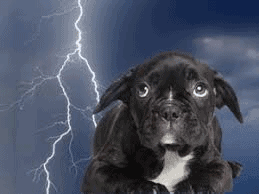Reactions to thunderstorms are not uncommon: loud noises from overhead are difficult for dogs to process and understand. While many dogs get accustomed to storms over time, others may become more anxious with ongoing exposure. Even a single frightening event during a storm may contribute to your pup’s fear.
The degree of anxiety is based on your pet’s perception of a threat. When a dog’s response to thunderstorms is extreme, it is considered a phobia.
Symptoms
Dogs may show a variety of anxiety signs during or before a thunderstorm: panting, trembling, hiding, pacing, vocalizing, and being destructive. Diagnosis is clear when the signs occur consistently during a storm or loud thundering noises. However, some dogs with separation anxiety also have phobias to thunderstorms. Owners may notice that an already nervous pet becomes even more anxious during storms.
Management
Dogs may try to hide to avoid a thunderstorm; this is a normal response. If your dog seems agitated or restless, you may be able to assist him in securing a safe haven and help him/her relax during storms. This safe location should be readily available, especially when no one is home.

You can try to limit exposure to the overwhelming and fear-evoking elements of a storm by closing doors and windows, and using white noise or music to block out the sounds. When you are present, you can engage your dog and redirect other things such as obedience exercises, fun activities (agility or food puzzle toys) or relaxation responses.
Each dog and family may need to implement different strategies based on their dog’s unique response. If your dog shows little or no response to storms, you need not do anything.
Pharmacological and Pheromonotherapy
For very anxious animals, it is essential to reduce anxiety during a storm to prevent worsening of the anxiety and allow management and treatment options to be successful. Select interventions based upon the severity of the anxiety and the severity of the storms.
Dogs with severe anxiety most of the time may benefit from long-term management with medications such as fluoxetine or clomipramine. They may even need rapidly-acting anti-anxiety medications like Xanax, that may be given right before a storm.
Intermediate cases that only occur during loud-noise events may require only rapidly-acting medications such as Xanax or other drugs in this class. These drugs can be given immediately prior to or during a storm.
Pheromone intervention such as D.A.P.® Dog Appeasing Pheromone or Adaptil which can be used alone or combined with another intervention, can be used with a continuous diffuser or the spray can be used as an immediate intervention.
Treatment
Ignoring severe anxiety or extreme displays when the dog is not likely to adapt naturally is not necessary, and may be confusing and could contribute to your dog’s anxiety. If his anxiety persists, seems extreme or your pet is at risk for self injury, be sure to consult your veterinarian.


